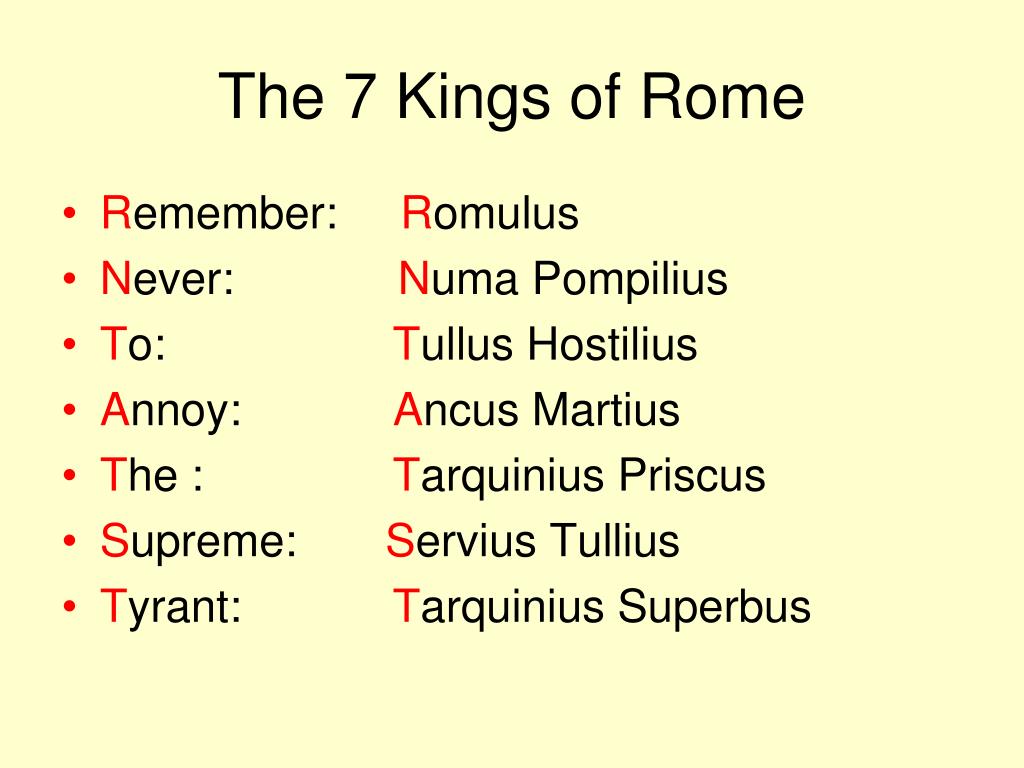

Account Īccording to the traditional account, a group of aristocrats overthrow the last king, Lucius Tarquinius Superbus, in response to the rape of the noblewoman Lucretia by the king's second son, Sextus Tarquinius after revealing the rape to some noblemen, Lucretia commits suicide. Archaeological evidence indicates there were kings in Rome but many modern scholars doubt the traditional narrative and believe its characters and details to be largely the product of later literary invention. Roman tradition held that there were seven kings of Rome who reigned from the city's founding (traditionally dated to 753 BC) by Romulus up to the reign of Tarquin.

See also: Roman Kingdom, Lucius Tarquinius Superbus, and Lucius Junius Brutus Resolution of this topic is difficult, however, due to the absolute paucity of reliable sources such that – as the historian Fred Drogula remarks – "we have no way to prove or disprove most of the information contained ". Many historians have argued that the fasti are "an unreliable product of the late republic whose accuracy regarding the early republic is minimal". This relates mainly to debate over whether the earlier entries on the consular fasti are fabrications. However, modern scholars are sceptical of much of this traditional chronology, especially that related to the dedication of the capitol. Because his temple was dedicated in 303 BC, this implies the capitol – which traditionally was held to have been dedicated in the first year of the republic – was dedicated in 507. according to a census in 389 or 388 BC, 119 years before it (implying 508 or 507 BC), Ī further account is given by Gnaeus Flavius, who asserted his temple to Concordia was dedicated 204 years after the dedication of the capitol.according to Polybius, 28 years before Xerxes crossed into Greece (implying 508 BC), or.according to Dionysius of Halicarnassus, in the first year of the 68th Olympiad or the year Isagoras was eponymous archon at Athens (implying 508–7 BC),.Later historians reported dates roughly around that time, implying that the republic was founded: Of course, this would have relied on the lists of consuls being accurate. The fasti Capitolini – relying on the Varronian chronology – go back to 509 BC Livy's list of consuls points to the republic having began around 502–1 BC. The simplest way for the Romans to have known how long their republic had existed would have been to look at the list of consuls, of which two were elected every year, and simply count the number of consular pairs to impute that the republic had existed for however many years corresponded. Varronian year 344 corresponds to real year 340 BC). The specific dating to 509 BC emerges from the Varronian chronology, assembled during the late republic by Marcus Terentius Varro and later used by the fasti Capitolini, which likely – in the earlier period – runs four years behind the actual dates (i.e. The most well known date for the establishment of the republic, and therefore, the expulsion of the kings, is 509 BC. Scholars and the ancient sources themselves disagree on when the monarchy was overthrown and how old the resulting republic was. Various scholars have dismissed aspects of the traditional story, from the historicity of almost all of its major characters to the overthrow's entire existence. There does not exist, however, any concrete evidence for or against it. Many modern scholars dismiss this narrative as fictitious. Despite a number of attempts by Lucius Tarquinius Superbus to reinstate the monarchy, the Roman people are successful in establishing a republic and thereafter elected two consuls annually to rule the city. The Roman army, supporting Brutus, forces the king into exile. The Roman noblemen, led by Lucius Junius Brutus, obtain the support of the Roman aristocracy and the people to expel the king and his family and create a republic. Upon revealing the assault to some Roman noblemen, she kills herself. The traditional narrative involves a dynastic struggle in which the king's second son, Sextus Tarquinius, rapes a noblewoman, Lucretia. 509 BC, but this narrative is largely believed to be fictitious by modern scholars. The details of the event were largely forgotten by the Romans a few centuries later later Roman historians invented a narrative of the events, traditionally dated to c.

The overthrow of the Roman monarchy was an event in ancient Rome that took place between the 6th and 5th centuries BC where a political revolution replaced the then-existing Roman monarchy under Lucius Tarquinius Superbus with a republic.


 0 kommentar(er)
0 kommentar(er)
